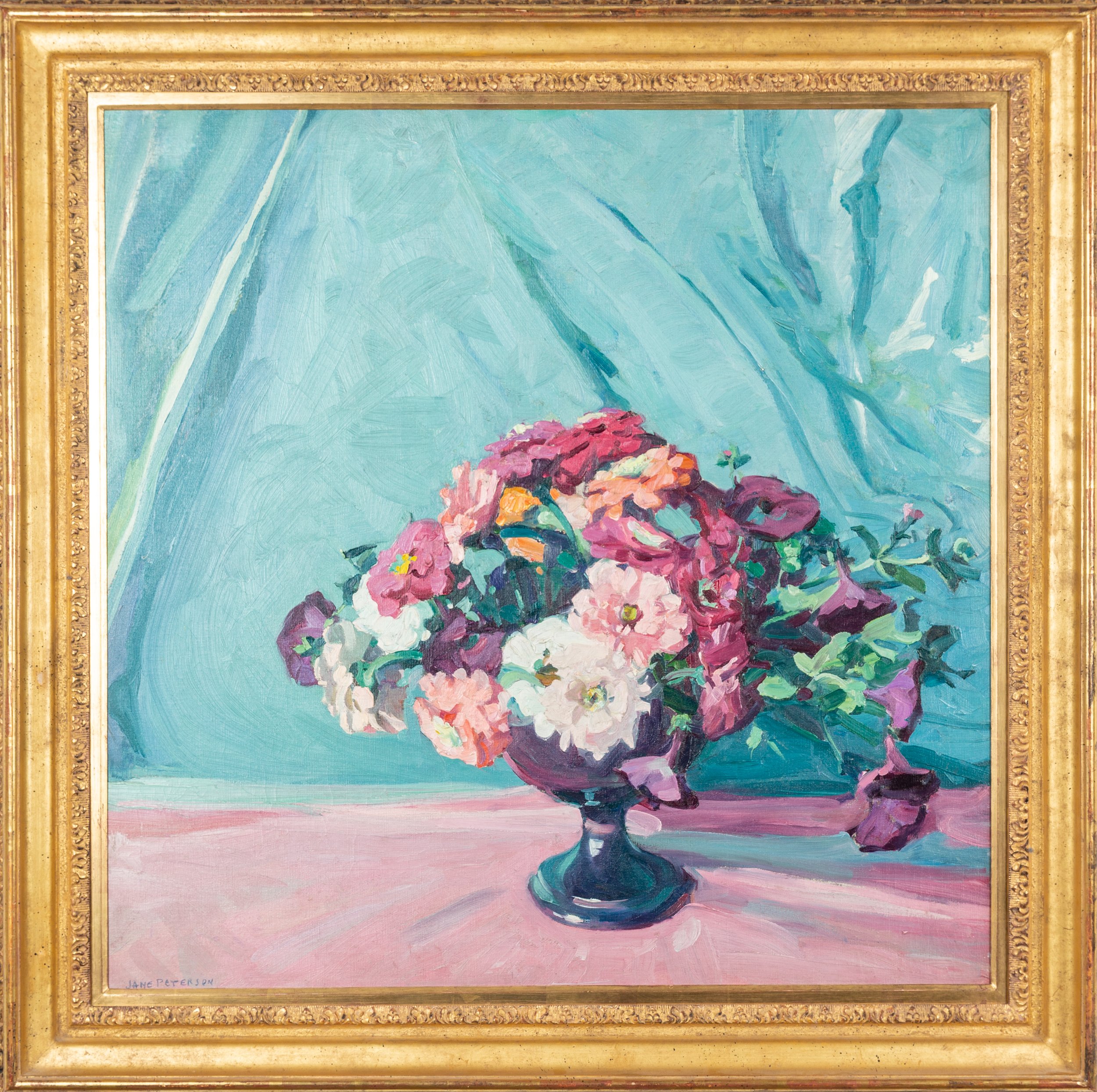Jane Peterson, “Amethyst and Jade,” no date. Oil on canvas. Floral still lifes—Peterson called them floral portraits—make up half the works In Endicott College’s “Jane Peterson: The Principal of Beauty.”
Artist’s biographies can mislead. Someone met this influential person, and did this. Or someone’s family was connected, which led to that. Or studied with whomever, and accomplished this or that.
Jane Peterson (1876–1965) was born to paint. Her connections, and her success, reflect her own determination. A public school education in Illinois couldn’t stop her from becoming an artist, and a bold move to New York City—at 17, with $300 loaned from her prescient mother—led to more formal artistic education at Pratt Institute and the Art Students League.
Peterson soaked up the art world around her in New York, and then at artistic destinations like Venice, Paris, Holland, Madrid, North Africa, Ogunquit, Newport, Provincetown and Gloucester.
She painted everywhere. A modest exhibition—“Jane Peterson: The Principal of Beauty,” with sixteen works showing in the Heftler Visiting Artist Gallery at Beverly’s Endicott College—cracks open her vast expressive catalog of landscapes, still lifes and portraits.
Floral still lifes—Peterson called them floral portraits—make up half the works. The unspectacular gallery barely hints at the volume of Peterson’s work, but it shows her stylish attitude, her rooted sense of composition, and ideas of color harmony. Nothing is either rigorously traditional or explosively shocking—there’s no “big, red, shiny” here—but personal, insightful, pleasing and unusual.
Peterson’s travel life, up to age 50, was breathtaking. In the ’00s, teens and early ’20s of the past century she ranged from Alaska to Turkey. Her first solo exhibitions—in Paris in 1908, followed shortly after with another in Boston—had almost a hundred paintings, and cemented her professional security as an artist, if nothing else.
At 50, she married Bernard Phillip, a wealthy New York lawyer. From then on, Peterson painted mostly in their New York townhouse—a rooftop studio opposite the Metropolitan Museum of Art—or in their Ipswich summer estate. Most of the floral portraits in “The Principal of Beauty” come from this later period.
Her intersections were notable—Gertrude Stein, Louis Tiffany, Jacques-Émile Blanche, Arthur Wesley Dow (a primary mentor), the Spanish Impressionist Joaquìn Sorolla. She made astute, lasting connections with multiple patrons and art lovers, and her work was shown extensively throughout her life, and remains vigorously collected.
This exhibition simply touches on that spacious artistic life. Of the sixteen works, all minimally labeled, there are a dozen oils, with a pair each of watercolor and gouache.
Only one painting, of Saint Mark’s Square, represents years of work in Venice. Similarly, single paintings from Paris, Brittany, and Cape Ann stand for dozens of works from those locals. The confident “Portrait of a Female Officer” presides as the only human presence.
Most of the works are Impressionistic floral arrangements, not meant to shock with subject matter but meant to attract through composition and color harmony. There are striking background choices: Tiger lilies fight to compete with an attention-grabbing green background; orchids as well, painted against stormy gray; a carefully arranged vase, almost hastily painted, retreats into a background of magenta and cyan.
Peterson lived with a determination to paint, and achieved that goal magnificently. “Jane Peterson: The Principal of Beauty” invites the viewer to open the door to the larger world of her work. The exhibition runs through Jan. 28, 2022 in the Heftler Visiting Artist Gallery, Manninen Center for the Arts, Endicott College, 376 Hale St., Beverly. Visit endicott.edu or call 978 232-2250.
Keith Powers covers music and the arts for Gannett New England, Leonore Overture and Opera News. Follow @PowersKeith; email to keithmichaelpowers@gmail.com.


